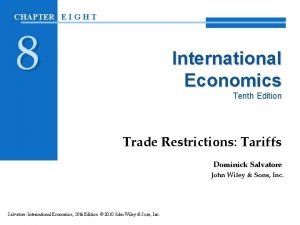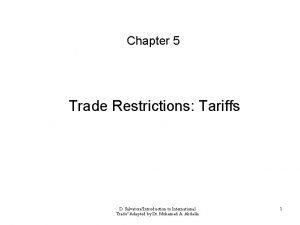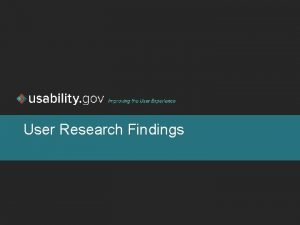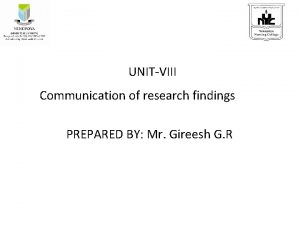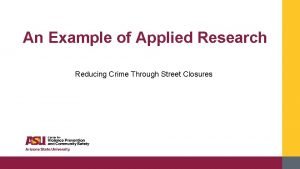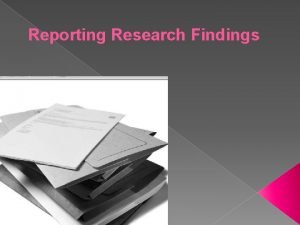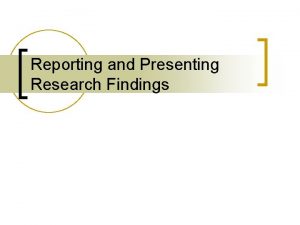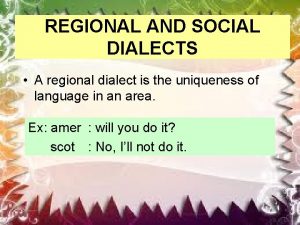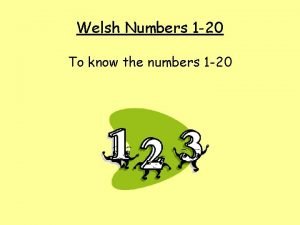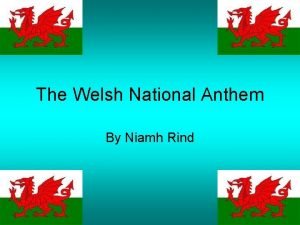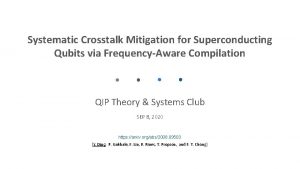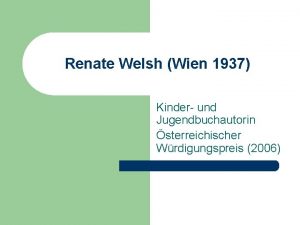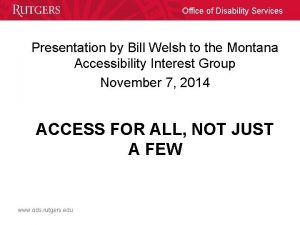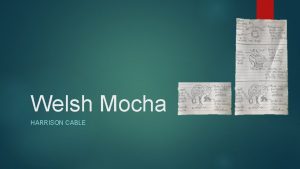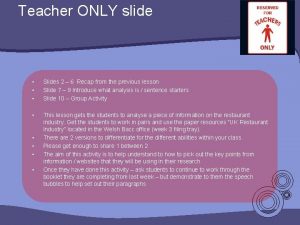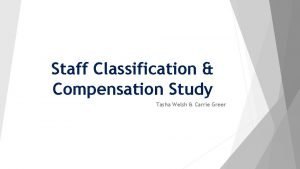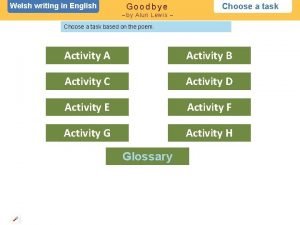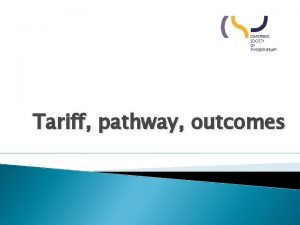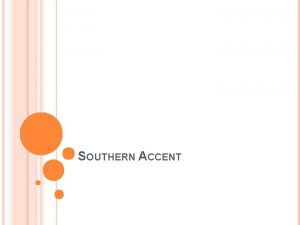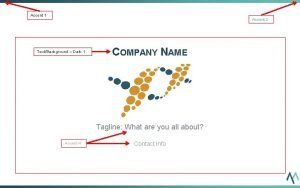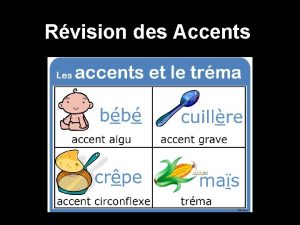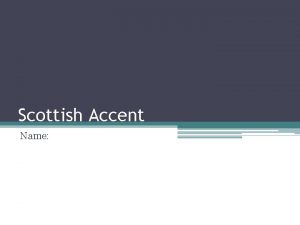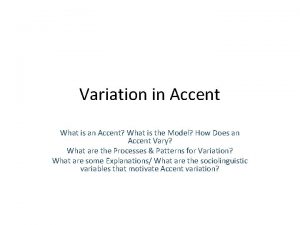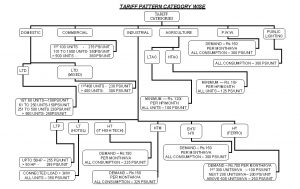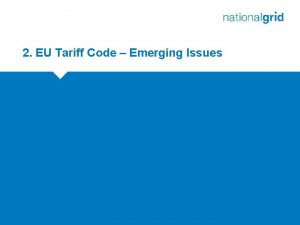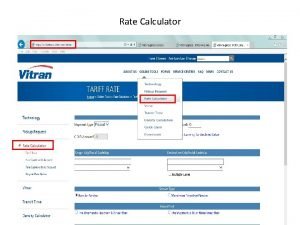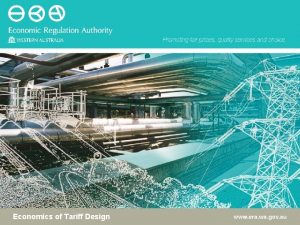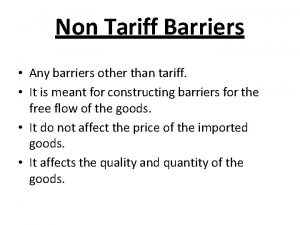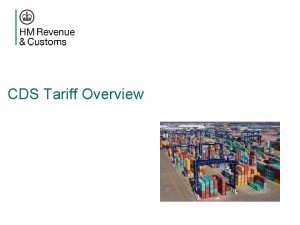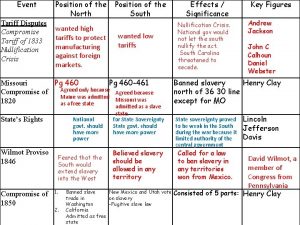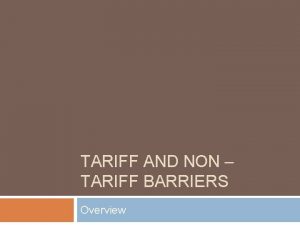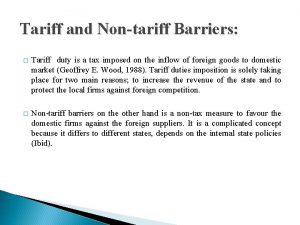Welsh Water Social Tariff Research Quantitative Findings Accent


































- Slides: 34

Welsh Water Social Tariff Research Quantitative Findings Accent is registered to the market, opinion and social research International Standard ISO 20252 March 2014 © Accent 2014 Rachel Risely Tel +44 (0)20 8742 2211 Rachel. Risely@accent-mr. com

AGENDA • Research background including qualitative summary refresher • Methodology & sample • Customer views on current charges • Acceptability of the Social Tariff • Summary of quantitative results slide 2

Research Background & Qualitative Summary Refresher slide 3

Research Objectives Overarching objective is to assess customer attitudes to the introduction of Social Tariffs and willingness to pay for them • Understand the degree of support for a Social Tariff • Assess response to idea of cross subsidies • Explore design of Social Tariff • Assess levels of willingness to pay Core quantitative objective: to measure support and willingness to pay for proposed Social Tariff slide 4

Qualitative Summary • Low awareness or consideration of existing cross subsidies in the water industry or other service sectors • Spectrum of support for DCWW cross subsidy • Strong supporters and strong opposors are in the minority • Majority demonstrate a high degree of conflict and present as persuadable Commitment to support or oppose the cross subsidy are based on 4 core factors • Potential gain or loss • Personal economics • Social perspective • Knowledge and understanding of DCWW • • Issues are related to the principle, practical and personal • This is Welsh Government territory • Not even DCWW responsibility so definitely not mine • Concerns over controls based on potential recipients e. g. time of qualification, usage restrictions • Concerns over accurate identification of recipients • Need for costs to be managed carefully and not spiral • Impact on personal financial situation • Figures presented were surprising and added to increased support • Amount of proposed increase was lower than anticipated • Amount of bill reduction was higher • 20 -25% feels like a good reduction • £ 6 -£ 12 a year acceptable for supporters slide 5

Summary • Half agreed that their current water and sewerage bill charges are affordable – although this was lower among SEG DE (25% disagree compared with 15% overall) – and those on benefits (23% disagree compared with 10% of those not on benefits) • Following information, 82% felt it acceptable for DCWW to introduce a new scheme to help customers genuinely struggling to pay • Acceptance of the scheme remained high (81%) when the banded scheme was explained • Part-funding of the scheme by DCWW and an acceptance of water efficiency measures by participants are crucial • 75% of customers accept the introduction of the proposed social tariff at an additional charge of £ 15 pa slide 6

Methodology & Sample slide 7

Research Methodology Integrated research programme combining qualitative and quantitative methodologies Inception workshop Pre- Placement Exercise Qualitative: Deliberative groups Quantitative: Measurement and financials This debrief will focus on results from the quantitative element of slide 8 this project

Research Sample 400 CATI interviews and 40 face-to-face interviews with Welsh Water customers responsible for paying the water bill SEG AGE AB C 1 C 2 DE 18 – 34 12 19 16 12 35 – 49 33 19 25 30 50 – 64 30 29 22 35 65 – 74 36 12 21 23 75+ 18 12 13 23 Table shows actual numbers of respondents by age and SEG CATI average interview length: 24 minutes Research was conducted by Accent’s Telephone Unit in Edinburgh Pilot: 45 interviews (14 th – 16 th January 2014) slide 9 Main stage: 355 interviews (17 th – 27 th January 2014)

Classification Questions 41% of all respondents receive some kind of benefit. 51% of all respondents have an annual household income of less than £ 24, 000 42% of all respondents have a long-term illness, disability or infirmity. Of those, 84% said it limits their activities in some way. 28% of all respondents had children in their households (aged under 16).

Customer Views on Current Charges slide 11

VFM perceptions Two thirds feel water bill represents good value for money Those aged 75+ and metered customers were significantly more likely to feel it was “very good value for money”. Q 10: How do you rate the service you receive form Welsh Water in terms of value for money? Please respond on a scale of 1 to 5 where 1 represents very poor value for money and 5 represents very good value for money. Base: All respondents (n=440) slide 12

Half agree their current water and sewerage bill charges are affordable • Metered customers were significantly more likely than those without meters to strongly agree. • Those on benefits were significantly more likely to disagree Q 17: On the following scale, how much do you agree or disagree that your water and sewerage/water/ sewerage (AS APPROPRIATE) charges are affordable to you? Base: All respondents (n=440) slide 13

Nearly two thirds rated their water bill better value for money compared to their electricity and gas bill and council tax Q 18: How much do you agree or disagree with the following statements … My water and sewerage bill is better value than my electricity and gas bill My water and sewerage bill is better value than my council tax My water and sewerage bill is better value than my telephone and/or broadband bill Base: All respondents (n=440) slide 14

16% were aware of any schemes that Welsh Water offers to help their customers Spontaneous Awareness Payment Plans Of those who were aware of any schemes, one third spontaneously mentioned Payment Plans 32 Weekly Direct Debits 19 Welsh Water Assist • Of those who were not aware of any schemes, the majority, 75%, had not heard of any when prompted. • 15% were aware of Payment Plans and 14% Weekly Direct Debits when prompted 18 Water Direct 3 Customer Assistance Fund 3 Other 54 0 10 20 30 40 50 60 70 % Respondents Q 20: What schemes are you aware of that Welsh Water already have to help people pay their bill? (SPONTANEOUS) Base: All respondents aware of schemes offered by Welsh Water to help customers pay their water/sewerage bills (n=72) 80 90 100 slide 15

Acceptability of the Social Tariff slide 16

Three quarters found a reduced tariff for customers on low incomes acceptable • C 1 C 2 s were significantly more likely to say “don’t mind” than DEs. • Customers on the lowest incomes were significantly more likely than those on middling incomes to find it “perfectly acceptable”. slide 17 Base: All respondents (n=440)

Respondents were shown background information on DCWW 45% were aware that DCWW has no shareholders and uses its profits to improve services to customers and keeps bills as low as possible Following further information, 82% felt it was acceptable for DCWW to consider introducing a new scheme to help customers who are genuinely struggling to pay X Base: All respondents (n=440) slide 18

13% are aware of other schemes in other areas of life where some customers pay more than those on lowest incomes Whether the DCWW scheme would be similar to … Base: All respondents (n=440) slide 19

One third felt that the 160, 000 DCWW calculates are struggling to pay is about the number they expected Q 28: Please now look at Showcard C which sets out the number of customers within Welsh Water’s area who are estimated to be genuinely struggling to pay their water bill. Do you think this number is … Base: All respondents (n=440) 160, 000 slide 20

81% felt the banded schemes, with customers on the lowest incomes receiving the most help, were acceptable Those claiming benefits were significantly more likely to feel it was “perfectly acceptable” than nonclaimants. Q 30. Please now look at Showcard D. This outlines how Welsh Water could structure assistance for different customers. How acceptable to you is this approach (ie a banded scheme, with customer on the lowest incomes getting the most help)? Base: All respondents (n=440) slide 21

Six in ten felt it “very important” that DCWW funds part of the scheme Q 31. If introduced, Welsh Water would part fund the scheme. How important is it for you that Welsh Water funds part of this scheme from its profits? Base: All respondents (n=440) slide 22

Eight in ten felt it is important that participants have to accept water efficiency measures Q 32 a. If introduced, it could be a requirement that customers who qualify for the scheme have to accept some water efficiency measures. How important is this for you? Base: All respondents (n=440) slide 23

Willingness to pay 75% of customers accept the introduction of the proposed social tariff at an additional charge of £ 15 pa Annual increase Q 32–Q 37. Customers who contribute to the scheme would pay an additional amount on their annual water bill from April 2015. Customers will not pay any more than a fixed amount per year towards the scheme. This value will not change by more than inflation. Welsh Water is committed to ensuring that all eligible customers will be accepted onto the scheme. It will bear all administration costs and is willing to make a substantial contribution to help reduce the costs incurred by other customers. If Welsh Water increased other customer’s bills by £ 7. 50/£ 12. 50/£ 15/£ 17. 50/£ 20 slide 24 a year, how acceptable would that be to you? Base: All respondents (n=440)

Acceptability summary Majority support for introduction of Social Tariff at all points Support consistent once scheme explained Only declines marginally at Wt. P £ 15 pa *Acceptable includes “don’t mind” ** Unacceptable includes “don’t know” slide 25 Base: All respondents (n=440)

Summary of Quantitative Results slide 26

Summary of current rates • Two thirds felt their water bill represents good value for money • Half agreed that their current water and sewerage bill charges are affordable – although this was lower among SEG DE (25% disagree compared with 15% overall) – and those on benefits (23% disagree compared with 10% of those not on benefits) • Nearly two thirds rated their water bill better value for money compared to their electricity and gas bill and council tax • Only one in six were aware of any schemes that Welsh Water offers to help their customers – and awareness remained low, even when prompted with the scheme names

Summary of the proposed tariff • Three quarters found it acceptable (or didn’t mind) a reduced tariff for customers on low incomes • Following further information, 82% felt it acceptable for DCWW to introduce a new scheme to help customers genuinely struggling to pay • Around seven in ten could liken the DCWW scheme to cheaper gas and electricity for the elderly, cheaper travel for pensioners etc and free school meals for low income families • Acceptance of the scheme remained high (81%) when the banded scheme was explained • Part-funding of the scheme by DCWW and an acceptance of water efficiency measures by participants are crucial • 75% of customers accept the introduction of the proposed social tariff at an additional charge of £ 15 pa

slide 29

Showcards slide 30

Show Card A - Background Dwr Cymru Welsh Water provides water and sewerage services to over 1. 2 million homes in Wales and some bordering areas of England. Welsh Water is responsible for providing three million people with: • a continuous, high quality supply of drinking water, • collecting wastewater, • Treating and properly disposing of the wastewater that is produced. Welsh Water does not have any shareholders and all profits are reinvested to improving the service and keeping bills as low as possible. It is proud to have been one of the top three Water companies in England Wales for quality and service for the last three years It has just been awarded the “Wales Responsible Large Business of The Year”.

Show Card B – Helping customers who are struggling Welsh Water knows that utility bills can be a burden on households, particularly during tough economic times. It aims to make water bills more affordable for all customers, particularly those in genuine financial difficulties. Welsh Water has already introduced schemes to help some of these customers including Welsh Water Assist , helps over 25, 000 vulnerable customers. However, research shows that many more customers struggle to pay their water bill and Welsh Water can only provide support to more customers who help needed, if other customers are prepared to pay a little bit more. It is important for Welsh Water that the introduction of any new scheme is balanced by keeping bills affordable to all customers.

Show Card C – Number of customers in need of assistance Welsh Water is looking to help those households with the lowest incomes because they are the most likely to be genuinely struggling to pay their water bill. The average household income of Welsh Water’s customer is £ 32, 600 a year. Welsh Water wants to help households whose total income is less than £ 13, 000. That is £ 250 a week. This would help about 160, 000 customers. Welsh Water’s average household water and sewerage bill is £ 434 a year, which is £ 8. 35 a week. A proposed average saving of £ 100 a year would be almost a quarter of the bill, which will make a meaningful difference for households on low income

Show Card D – Structure of Assistance Welsh Water would look at the total income of the entire household to decide whether they qualify for the scheme. There will be four bands of charges based on the level of total household income (as shown in the table below) Band Household Income From A Average Saving The most they will pay each year % average saving To £ 5, 600 £ 250 £ 184 58% B £ 5, 601 £ 6, 700 £ 180 £ 254 42% C £ 6, 701 £ 8, 600 £ 115 £ 319 27% D £ 8, 601 £ 12, 500 £ 55 £ 379 13% Those in the lowest band will receive the highest level of support. Eligible customers will receive help in how to use water more wisely. Welsh Water will bear all administration costs and is willing to make a substantial contribution to help reduce the costs incurred by other customers.
 Ad valorem tariff vs specific tariff
Ad valorem tariff vs specific tariff Ad valorem tariff vs specific tariff
Ad valorem tariff vs specific tariff Water and water and water water
Water and water and water water Grade 11 maths literacy tariffs
Grade 11 maths literacy tariffs Chapter 10 qualitative research designs
Chapter 10 qualitative research designs Significant findings example
Significant findings example Communicating research findings in nursing
Communicating research findings in nursing Kind of quantitative research
Kind of quantitative research Results and discussion
Results and discussion Qualitative vs quantitative
Qualitative vs quantitative Research findings example
Research findings example Translating research findings to clinical nursing practice
Translating research findings to clinical nursing practice Conclusion of motivation
Conclusion of motivation Reporting research findings
Reporting research findings Presenting research findings
Presenting research findings What is regional dialect in sociolinguistics
What is regional dialect in sociolinguistics Social thinking adalah
Social thinking adalah Social thinking social influence social relations
Social thinking social influence social relations Welsh numbers 1-20
Welsh numbers 1-20 Welsh national anthem translation
Welsh national anthem translation Welsh-powell algorithm
Welsh-powell algorithm Welsh ghost stories
Welsh ghost stories Rules of snooker
Rules of snooker Dr van luijk wien
Dr van luijk wien Region coloring
Region coloring Bill welsh rutgers
Bill welsh rutgers Why we celebrate easter
Why we celebrate easter Welsh cup electrodes have
Welsh cup electrodes have Welsh mocha
Welsh mocha Welsh food
Welsh food Ruru welsh bacc
Ruru welsh bacc Tasha welsh
Tasha welsh Welsh bacc global citizenship personal standpoint example
Welsh bacc global citizenship personal standpoint example Mary welsh hemingway
Mary welsh hemingway Alun lewis goodbye
Alun lewis goodbye
